The Oldenburg area was the main source of coach horses in Germany but with the disappearance of the coach horse market in the early twentieth century, the existing type – developed from a mix of Friesians, Hanoverians, Normans, Cleveland Bays and Thoroughbreds – was made over and emerged as an all-round agricultural horse in the period between the wars.
The origins of the modern Oldenburger horse lie in the nineteenth century, with three significant events: the first stallion approval decreed by the state in the year 1820, the introduction of a register of origins in 1861 and the foundation of two horse breeding societies by the Horse Breeding Act of April 9, 1897. These two societies merged in 1923 to form today’s Verband der Züchter des Oldenburger Pferdes e.V.
An Oldenburg Stallion licensing 1870….
A traditional Oldenburg Auction in 1910
Here is the champion stallion, Fürst, born in 1940, showing that he can do a day’s honest work…
After WW2, the breed was refined and lightened, a process that was accelerated in the 1970’s with the arrival of a number of influential stallions – Furioso II (by the Thoroughbred, Furioso), the Thoroughbred Kronprinz (by Nizam), the French Anglo-Arab, Inschallah, Ultraschall (by Ultra Son) Tiro (by Tremelo), the Gotthard sons, Gepard, Goldpitz and Goldstern, the Der Löwe xx descendants, Löwen As (by Lugano) and Luciano (by Lukas), the Trakehners, Herbsturm (by Komet) and Magister (by Major), the Westfalien, Prinz Gaylord (by Perlkönig), and the two sons of the Thoroughbred Neckar, Vierzehnender xx and Volkron xx. They all contributed to the new look Oldenburg and played their part in the transformation from farm hand to Sporthorse.
Even in the 60’s they were solid lads! This is another champion stallion, Charmant, born in 1960
Lupus – A Derby winner…
The first measures to refine the breed were undertaken with the Thoroughbred stallion, Lupus xx, in 1935, and again in 1950 with the Anglo-Norman stallion, Condor. By the 60’s the turnaround in breeding towards the modern riding horse was well underway.
The Anglo-Norman, Condor
If the breeding success in Hanover is a fine example of benevolent State intervention, Oldenburg is a story of vigorous private enterprise. Here there is no state subsidised Stud, but an intensely competitive set of private stallion keepers each endeavouring to outdo the other in the publicity stakes. The Oldenburg breeders have always adopted a much more open breeding policy. They were amongst the first to travel to France, taking in both Selle Français and Anglo Arab blood, and in more recent times, have been the first to accept stallions from The Netherlands.
Recently some of the traditional stud families like the Klattes and the Vorwerks found themselves confronted by a new phenomenon, the stallion station of the super rich. At Sprehe, and to a lesser extent, Famos, expensive collections of stallions were assembled (in one year Sprehe bought ALL Germany’s licensing winners!) to create the instant super stallion station. And there is no shortage of funds for promotion – not just the usual hyper glossy brochures and ads, but Sprehe put on a foal show with €30,000 in prizemoney… of course the foals had to be by Sprehe stallions.
Suddenly the traditional stallion owners were making personal visits to admire their (somewhat startled) clients’ foals and join them in a quick glass of schnapps. At the end of the day, the sky did not fall in. Sprehe seems to have recognized that it bit off rather more than it could chew, and sent their dressage stallions to one of the first of the glam private studs, Gronwöhldhof, keeping the jumping sires at their super purpose designed facility at Löningen-Benstrup.
But the situation was to get worse for the old private studs, and by 2014, most of the famous old studs have closed, with really Sosath the only traditional stud in operation!
The number of Oldenburg foals born in 2006 was 4,141, in 2007 the number was 4,446. The number of Oldenburg foals born in 2013 was 3.710. Currently there are about 400 stallions on the Oldenburg stallion roster.
The auctions for riding horses in Vechta started in 1974 with an average price of 9775 DM. By 1990 the average price had risen to 27,351 DM. At the fall 2007 Auction, the average price had rocketed to €31.704.
The 2007 Winter Auction showed how far the Vechta auctions have come, with two international dressage stars, Canadian Evi Strasser and Austria’s Sissy Max-Theurer in a bidding war for the top seller, Equipage (Sandro Hit / Feiner Stern). The horse eventually went to Austria for €113,000, while Ms Strasser had to settle for Wonderful Dream (by Welt Hit II) for €85,000. Fifty-four riding horses were sold for € 1,065500 at an average of €19,731. Nearly half the horses were sold abroad – to Spain, Belgium, Monaco, Great Britain, The Netherlands, Canada, Iran, USA, Austria, Finland, Russia and Switzerland.
The foal auctions started in 1979 the average price: 6752 DM. In 2007 at the Elite foal auction the average was €13,644.
At the fall auction 2014 the average price was €43,868 for the riding horses and €14,867 for foals. In 2014 the Elite foal auction average was €11,919.
Oldenburg – the innovators…
If it was an innovation to have stallions that were also competitors, it is another innovation to have a top breeding official who is also a current top line competitor: Katrin Burger rode French Kiss to a World Young Dressage Horse Championship in Verden 2004 , and even after she took on the position of Vice-Breeding Director of the Oldenburg Verband, she continues to compete in Young Horse classes.
Katrin is a welcoming, and refreshingly frank addition to the ranks of Germany’s breed association officials, a group that seems to become younger and more ‘modern’ as every minute passes.
The Oldenburg breeders seem to have been amongst the first to start to produce a modern type of Warmblood – do you think that has something to do with the structure of the Oldenburg Verband?
“The Oldenburg Association had to work hard. In Oldenburg, they had old-style black carriage horses, they were very famous and the whole breeding was structured to produce the best carriage horses – and they were very successful. It meant Oldenburg had heavy horses, they didn’t breed for the Army, like the Trakehners, only for carriage, so it was really hard work to change the carriage horse to a riding horse. They were the first to use a lot of Thoroughbreds. We had very famous Thoroughbreds in our breeding after the Second World War, and they are still very important in our pedigrees.”
“Thanks to the Thoroughbred, our horses became modern very very fast. The breeders had to produce a new type of horse, they had to make a break and start almost from the beginning, but they had to use the older style mares, there were no other mares for them to use.”
“One of the first important Thoroughbred stallions was Adonis xx. Then we had a number of others, Manolete xx and his half brother, Miracolo xx, the English Thoroughbred, More Magic xx. I think very important were Vollkorn xx, Makuba xx and Kronprinz xx. You will still find all those stallions in the pedigrees, toward the back of course because it was some time ago. But if you look at the photos you can see those Thoroughbreds did not look like the Thoroughbreds of today.”
BACKGROUND: The Thoroughbreds of Oldenburg
(The following information is from Das Oldenburger Sportpferd by Roland Ramsauer, published in 1978. I am indebted to Katrin Burger of the Oldenburg Verband for the translation)
Adonis xx:
(Magnat xx, M. Aster xx by Oleander xx – Wallenstein xx. Born 1952)
Description: Medium sized, fine stallion with good face, a little weak in the back, regular frame and limbs with a little too much angle in the hind legs, regular gaits.
Career: Stood from 1959 until 1963 in the Oldenburg area at the stallion station of L. Kathmann in Holtrup. First Thoroughbred to begin the change of breeding, sold to State Stud in Dillenburg 1964.
Genetic legacy: Good heredity for breeding horses, fitted best with heavy mares, excellent genetics for sport horses in all disciplines, especially some outstanding horses for eventing.
He produced 10 licensed sons, and 26 premium mares (11 State Premium, 15 Verband Premium).
The offspring of Adonis were amongst the most successful in Germany. His offspring won 175.304,– DM in 12 years (making him the second most successful of all Oldenburg stallions in that time). Adonis was the most successful stallion in the whole of Germany in 1971 on the basis of the number of offspring placed in sport; in 1972 he was in the second place.
Adrian xx:
(by Almeido xx, M: Agraffe xx by Gamsjäger xx – Travertin xx. Born 1963)
Description: Very beautiful, elegant stallion, medium sized with very correct frame, limbs and good gaits.
Career: Retired sound after 76 starts on the race track, GAG 80 kilos. Winner of his class at the show for Thoroughbreds in Köln in 1968 and 1970. In 1970 he was reserve champion of the whole show. He commenced his breeding career in 1971 at the stallion station in Sillenstede.
Genetic legacy: Very good heredity for breeding horses, the first offspring showed good results in sport, several good auction horses
16 premium mares (7 State Premium, 9 Verband Premium)
Bucephalos xx:
(by Agio xx. M: Bella Donna xx by Magnat xx – Ferro xx. Born 1966)
Description: Medium sized, sympathetic Thoroughbred with good limbs, well-muscled and excellent gaits.
Career: Bred in the famous stud of Schlenderhan he had a GAG of 80,5 kilos. Very good pedigree out of the motherline of the mare, Blaue Donau. He was based on the Vorwerk stud from 1971 till 1974, in 1974 he retired.
Genetic legacy: Good heredity for broodmares, but a little narrow in frame. Remarkable, that the colts mostly have a big frame and with good potential for a sport career.
17 premium mares (7 State Premium, 10 Verband Premium)
Kronprinz xx:
(by Nizam xx, M: by Kaiserkrone xx by Nebelwerfer xx – Bubbles xx. Born 1960)
Description: Very beautiful, medium sized stallion with a lot of expression. Good withers and neck, very beautiful head, a little fine but correct frame and limbs, outstanding gaits.
Career: Famous line of the Zoppenbroicher Kaiser family, successful career on the race track with a GAG of 90,5. The stallion stood always at H. Ahlers in Bümmerstede
Genetic legacy: Good heredity especially in making broodmares, some successful sporthorses
As of 1978, 23 premium mares (16 State Premium, 7 Verband Premium), his offspring were successful competition horses.
Manolete xx:
(Asterios xx, M. Malta xx by Allgäu – Oleander xx. Born 1955)
Description: Beautiful stallion with good expression and long lines but a little flat in the croup, good strong frame and limbs with good gaits.
Career: Second Thoroughbred at the Schlenderhan stud after Adonis xx
Genetic legacy: Good success in producing brood mares, excellent offspring in sport with some outstanding products
6 licensed sons: Markant, Mangold, Markus, Manfred, Marinus, Marius
19 premium mares (10 State Premium, 9 Verband Premium). He produced in 1972 and 1973 the most successful Oldenburg sport horse.
(Goody xx, M. Mainburg xx by Gundomar xx – Janus xx). Born 1956)
Description: Tall, distinctive stallion with a lot of expression, a fine face, medium sized frame and limbs and good gaits.
Career: GAG 82 kilos, winner of all classes at the Thoroughbred show in Köln 1965. Same motherline as Maigraf and Marcio which were used in Hannoverian breeding. 1966 until 1972 at Ludwig Kathmann’s, then sold to Bavaria.
Genetic legacy: Very good, uniform heredity, mostly with dark coats for breeding horses, outstanding heredity for sport horses with very good rideability and very good characters
4 licensed sons, none of which had much success in breeding
35 premium mares (21 State Premium, 14 Verband Premium)
Miracolo xx:
(Tantieme, M. Malta xx by Allgäu – Oleander xx. Born 1958)
Description: Big framed Thoroughbred with very good expression, excellent withers, good muscling and frame, outstanding gaits.
Career: Third Thoroughbred imported to Oldenburg after the Second World War, also coming from the Schlenderhahn stud. 1963 – 1972 at Vorwerk’s, then sold to Baden-Württemberg. Winner of the Thoroughbred show in Köln 1966 and 1968.
Genetic legacy: Excellent heredity for breeding, big framed offspring with good shoulders and withers, good results in sport
4 licensed sons, 41 premium mares (22 State, 19 Verband)
More Magic xx:
(by Vilmorin xx M: Jules Magic xx by Magic Red xx – His Highness xx. Born 1957)
Description: Medium sized stallion with good muscles and big lines, good fundament with small problems in the front legs, but with outstanding gaits.
Career: GAG 80 kilos, 1965 until 1972 at Vorwerk’s
Genetic legacy: Only grey offspring, very good heredity for breeding horses. Medium frame with good muscles, some excellent broodmares, produced riding horses with very good rideability for all kinds of sport.
5 licensed sons, 46 premium mares (21 State, 25 Verband)
Praefectus xx:
(by Primera xx M: Honey Portion xx by Major Portion xx – Hyperion xx. Born 1967)
Description: Very beautiful stallion with good muscles and frame, good shoulder, excellent croup, good frame, a little weak in the fetlock, very good gaits with good rhythm.
Career: Most expensive horse of the Thoroughbred auction in Ascot 1971. Stood at Vorwerks until 1975, then sold to Rheinland-Pfalz.
Genetic legacy: Good results for breeding, produced a lot of auction horses with good rideability. Good results in sport.
Vollkorn xx:
(by Neckar xx, M. Vogelwarte xx by Ansitz xx – Widerhall xx. Born 1961)
Description: Big framed Thoroughbred stallion with long lines and excellent withers, solid frame and limbs, excellent gaits.
Career: GAG 86,5 kilos, motherline similar to the Thoroughbreds, Vierzehnender and Venator. Breeder: G. Gäting, Esnshammer-Oberdeich.
Genetic legacy: Dominant, outstanding heredity for breeding and sport, produced outstanding broodmares and excellent sporthorses especially for eventing.
7 licensed sons, for example Volturno (winner of the licensing and main premium) 51 premium mares (31 State, 20 Verband)
But according to Katrin, the wonderful Thoroughbreds of the earlier era have all disappeared:
“All the breeders in Germany are looking for interesting Thoroughbreds, and at the moment we have the problem that the type of the Thoroughbred has changed so much. Maybe in Australia and New Zealand you might still have good Thoroughbreds that are big with long lines, with a really good shoulder, and uphill in the construction. The American Thoroughbreds at the moment, they have short front legs, a little like Quarter horses and bred to be very fast on a short distance. For a riding horse we need a totally different type. But the Thoroughbreds they used in Oldenburg in earlier times were really nice, I have seen the old photos because they were not in my time, but today we have difficulty finding Thoroughbreds like that.”
The Oldenburg Thoroughbred Quadrille at Equitana in 1975: Mamori xx with Klaus Böckmann, Praefectus xx with Rudi Rehkamp, By Rights xx with Wilhelm Schmidt and Thymian zz with Brigitte Schröder
“The other important factor is that we have no State Stud in Oldenburg. Characteristically for our Oldenburg breeding we have the private stallion stations, like Vorwerk, Klatte, Schockemöhle, Kathmann, Sosath and so on. They have to think like businessmen, they are able to change direction quickly because they have to earn money to stay alive. They have to offer the best stallions for their breeders to get enough mares. That makes the Oldenburg Association very strong. If you look at the pedigrees in all the auctions, all over Germany, you will find that the most expensive horses come from stallions in those studs. They sell their semen all over Germany and all over the world, anyone can use it. It is so important that our private stallion owners have to think like businessmen, not like public servants. They have to react if the stallion does not get enough mares, or the foals are not good enough, they have to change.”
Was the aim to produce jumping horses or dressage horses or all-round horses?
“After the War, I think the aim was to produce all-round horses and that is why the Thoroughbreds were so important to breed a good type. With Thoroughbred stallions, then you have to look to the offspring because none of them are tested in jumping or dressage. The problem we have with all Thoroughbreds is that the genetic heritage is not specialised for jumping or dressage, you just have to try and see what the result is. Luckily, we have the established mare lines and they are very important in Oldenburg. You can see that the good mother lines always produce the good horses, but in the beginning when they started, they just wanted to breed a good horse for sport and they used the horses for everything in that time. If they went to a competition it was normal to ride in dressage and jumping – some of the horses were also used as carriage horses. They had to be all-rounders at the time.”
Furioso II at the Oldenburg Stallion Licensing in 1977
When Furioso II arrived, was that a big break through for Oldenburg, the introduction of French blood?
“There were a few stallion owners, like Georg Vorwerk, who always tried to find special stallions. Mr Vorwerk was so ahead of his time in his thinking, to go to foreign countries and find the best stallions – he had good luck but he was also a real horseman. He found Furioso II and Inschallah x, both in France, and they had fantastic offspring in Oldenburg, and you can still find them in the very good lines. There were also other stallions coming from France in that time which had a big influence in the Oldenburg breeding like Zeus, Tiro or Futuro.”
Another of the Georg Vorwerk ‘discoveries’ – the French Anglo-Arab, Inschallah
“In his time, Furioso II was a very famous stallion, he made some dressage horses, but the most important thing was that he produced fantastic jumpers. They were also known not to have the best rideability but in their time they were a very modern type, with great potential in jumping. They were very attractive to the jumping riders who wanted to compete at the higher levels. In his time Furioso II was one of the most important stallions we had.”
“Very interesting is, that the line of Furioso II came back to Oldenburg through Westfalia’s Florestan and is now used as one of Germanys best dressage lines. At the moment Florencio, who started his carrer in Oldenburg, Fürst Heinrich, Fürst Romancier and Fidertanz are very famous stallions out of this family.”
“We don’t really have a big influence of French horses in Oldenburg now, because most of the French horses are not the typical Oldenburg type any more – they are mostly heavier, and some of them don’t have the rideability we need. The French horse they breed now, is just bred for success in international jumping competitions but of course we have some French stallions that are very famous and used in Oldenburg, like Quidam de Revel, or Baloubet de Rouet. If you can get the French horses with a good type, then they also fit to the Oldenburg horses.”
The most important jumping horses of modern times in Oldenburg are Argentinus and Grannus?
“I think so. Argentinus of course, without any discussion, he is one of the best stallions world-wide, of course, he is Hanoverian, but he has spent his career at an Oldenburg stud and had a huge influence on the Oldenburg breed. Argentinus is very special because he is also able to produce outstanding dressage horses. A lot of people forget that now because his jumping offspring are so successful in international competition but he has also had international dressage horses, and that makes him really outstanding, and that is not normal in our times when the breeding goes totally in two directions: dressage lines or jumping lines. Argentinus can make both.”
“Of course there were some other very important jumping stallions like Landadel or Zeus with very successful offspring.”
Was Donnerhall the beginning of the dressage specialist stallions?
“Maybe… the important thing with Donnerhall is that he was one of the first stallions who had to do both, who competed and was used in breeding. If you look at those stallions like Furioso II, they were never ridden, they did their performance test, and then they were shown at the stallion presentations, and they were not trained at all – they were just breeding stallions. Donnerhall showed both on the highest level.”
Donnerhall – one of the first dressage stallions who also starred in the competition arena…
“I know when I did my practical work before I started my studies, there was a big discussion on the stud where I worked about stallions competing. They were very afraid about having no success in the competitions and what people would say then. Yet now, it is normal – it is a must that the stallions compete. If they don’t compete, they don’t get the mares. So it was a big breakthrough with Donnerhall because he had such success in sport and he was a fantastic breeding stallion.”
“I can remember when I was at the Bundeschampionate when it was in Verden in 1992, and they had an evening Gala Show for Donnerhall, and there were so many of his offspring. It was the year that Davignon was Bundeschampion. It was really fantastic, I’d never seen anything like that before. That is why Donnerhall was so popular, because it was not normal in those times that a stallion competed. And he was a fantastic stallion in sport because of his offspring.”
Katrin loves those ‘D’ horses – here she is competing in the 3 year old Mares & Geldings at the 2007 Bundeschampionate on Daily Diamond by Day Dream by Don Gregory by Donnerhall…
You’ve ridden lots of horses of Donnerhall breeding – what does he put on his progeny?
“The most important thing is the rideability and the fantastic character, and – we say, the head, the inside of the head. They want to do a good job. They have good gaits, perhaps not as spectacular as the offspring of some other stallions, but they really want to do a good job. When we were running the stud at Schlossäcker, we always tried to find some interesting stallions, we went to all of the licensings to try and find something new, and I always had the problem that at the licensing, I always found the next stallion whose name started with ‘D’! We selected the stallions always for both, it must be a good stallion, and a good dressage horse. If you run a stud it must go forward – that means you ride a stallion for a few years, then you look at the offspring and you say ‘are they so good that we will keep the stallion, and still get enough mares, or do you sell the stallion as a dressage horse?’ That means that the trainability of the horse is very important so that you can sell them with a good profit as a competition horse. I always had the problem that we had two or three stallions whose name began with D, and always found new ones, also with D – which would be stupid to buy because you have that line already.”
“I like the D line very much because you know that they will go with you in a competition. I think that’s why lots of dressage riders like the D horses, you know what you are going to get out of the Donnerhall line…”
Rubinstein as a young horse
The next major break-through in Oldenburg came with a Westfalien stallion, Rubinstein?
“In that case our licensing commission did a really good job, because the young Rubinstein was not so spectacular as he was at the end – perhaps he was never spectacular in the gaits, but he had that fantastic character, outstanding rideability, and of course, his nice colour, fantastic walk and expression. I think especially in our times when all the crowds want to see the spectacular movement that Rubinstein is so important in the mother lines because they all have this special character and rideabilty. You can put them together with all the spectacular stallions and you will get a horse that not only has movement but also high rideability.”
Sandro Hit has been the major movement maker in the Oldenburg dressage mix?
“Without any doubt – now I have been in Oldenburg for more than two years, and you see it when you are standing there judging the foals, and the one coming in starts with the letter S, you always get happy because you know now you will have a lot of fun with a fantastic moving horse, nice type, long legs… some people believe that some of them some of them are not totally correct in the hind legs but I think that is nothing when you have so much fun seeing those horses dancing through the arena. It is really amazing, how similar his offspring are in their movement.”
Do you ever worry that there are so many sons and daughters of Sandro Hit, and now grandsons and grand-daughters, that it will be too much Sandro Hit blood in the Oldenburg gene pool?
“Of course, no discussion, it is a big problem in the whole of breeding in Germany. At the moment in all the associations, you will find a lot of Sandro Hit blood. In dressage we only have Sandro Hit, the D line which is becoming less, and I am a little bit worried about that, the R from Rubinstein, the W from Weltmeyer which was totally out in Hanover but now they discover it is interesting on the mother line, and the F from Westfalia. Five lines which combine together, and all Germany is looking for new stallions – for example, breeders are looking to The Netherlands because they breed interesting dressage horses. It may prove to be a big problem and as an association we are worried about it because we don’t want our bloodlines to come too close. We also have to be careful not to lose famous old lines, for example, the Bolero or Grande lines, which produced fantastic sport horses, but we have very few horses carrying this blood left in breeding.”
“We are all worried about what is happening, but the breeders get a lot of money for the progeny of the top stallions, so we can’t stop them using those stallions.”
You were saying earlier that one of the strengths of Oldenburg breeding was that you had the big breeders like Vorwerk, Klatte, Schockemöhle, who were able to make their own decisions quickly for the market – but is this also a problem, Mr Schockemöhle can ‘make’ a stallion… he buys the horse for a million euros and everyone wants to breed to it, but nobody knows what the foals are going to be like. Is it possible that these very powerful individuals who have pushed the breed ahead can become too dominant?
“Yes, I think that’s a problem in our times. I think it is not just the problem of the private studs, I think it is also the problem of the state studs – all the breeders think they have to use the young stallions. All the breeders run to the winner of the latest licensing, this stallion might have been presented under saddle at the stallion show, but no-one has any idea what the foals will be like, and when you have 400 to 600 foals in the first year, it’s very dangerous because if the progeny are not good enough you have quite a lot of foals without the quality you need. It is okay for the stallion owner, they have made their money, but if the foals are not good enough – then the stallion will go, and a new one will come. But the stallions that are doing the job well, they keep them because they will still get mares after two or three years. For me the big problem is that the breeders are not going to the really well-known, established stallions, stallions that have had good offspring over the years, who have offspring in international sport, except for one or two of these stallions, they have very few mares, and this is not right, in that case you know how the foals will look, you know which mares the stallion needs.”
“The other thing with the young stallions is that you have to work out which mare works with that stallion, it’s like a test. And the problem is, by the time you know which mares to use with that stallion, most of the breeders have moved on to the next winner of the licensing…”
“In our times in the ‘making’ of a stallion, the management has become very important. Not only the price at the auction but also the training later on. Only those studs with the good riders will get a lot of mares at the moment. That is also a kind of guarantee for the breeders, that the career of the stallion will go on, and they will be able to sell the foals.”
“So the question that sits there in the background, is – is it the genetic value of the stallion that gives him success in sport or at the performance test – or is it the good rider? It will still be very important for the breeders to look very closely at the heredity and the mother lines of the stallions, and not only at high prices or sports results!”
Is it also a problem that the breeders are breeding for the foal auction, and we are getting some very spectacular foals with their front legs waving about, but their necks are high and the back is hollow, and these might be very expensive at the foal auction but not very nice horses to ride?
“Maybe – you have some lines where you know they have good rideability but with a foal you can never say if it is going to be the perfect riding horse afterwards. With the high neck, it might just be that there are two people standing with whips and plastic bags and in that situation it is very normal for the little foal to stick its head in the air! You can look a little to the tail and see if it is loose or if there is a lot of tension. We always look when we select the foals for our Foal Auction that we have really interesting lines – that the mother line is a well-known line, because then there is a high probability that the foal will become a nice riding horse in the end.”
“You always have a problem that horses with a spectacular movement, they are only spectacular if they have a bit of power in them, and if they are a little bit sensitive, then you must have a good rider for them later on. It is not true that every rider can ride every horse, you really need a good rider for a spectacular horse.”
“When we select the foals we always try to select some foals which have a fantastic pedigree even though the foal is not so spectacular, but we know the line very well. In the Oldenburg breed, the mother line is the most important thing and something we should never forget – but in the end, the breeder mostly doesn’t get so much money for those foals, although they might be the better horses later in sport.”
Looking to the future, what do you see as the strengths for the Oldenburg Association – and what are the dangers?
“I think our strength is that we are an open association, very liberal. It means our breeders can use the best horses from all over the world – of course they must fit to our breeding rules, the stallions must have a performance test, full pedigree, etc – but if that is okay, they can use Hanoverians, Holsteiners, Westfalien, Netherlands, or any other country. It means they can go forward in breeding quite fast. I think that was the strength of the Oldenburg in former times, the policy is to have the best horses, and it is not important if they are 50% Oldenburg blood or not, what is important is are they the best.”
“Twenty years ago it would have been impossible to have the winner of the Licensing in Hanover with a pedigree – Sandro Hit / Donnerhall. Because our breeders are using the best lines, then our breeding is popular all over the world. For example, in recent years the Oldenburg Association has been the most successful at the World Championships of Young Dressage Horses in Verden. For two years running, we have won three of the six medals.”
“As to the problems, we have to try and make sure we have enough different bloodlines to use so that we don’t get too close with our pedigrees. We have to bring in new bloodlines in our breeding program, which is possible in Oldenburg – it’s no problem for a stallion owner in Oldenburg to buy a stallion from Holland, or France, and if the stallion is good enough, the breeders will use him.”
Winning at the World Championships 2008 for Oldenburg, Desparado – he’s by Dressage Royal, a combination of Donnerhall and Rubinstein. Photo: KH Frieler.
“We must be careful that the younger stallions don’t breed with too many of our mares, but that is very difficult for the Association to control, we can’t forbid the breeders to use the young stallions. In earlier times it was possible to restrict the number of mares to each young stallion, but there is a very strong European law with principles of equality, which makes it very hard to restrict the use of the young stallions, especially as the breeders know it is easier to sell those foals, as all the buyers are very interested in the first offspring of these highly publicised young stallions – and at the end for our breeders, the most important thing is the saleability of the horses they produce.”
Licensing 2014
The 2014 Oldenburger Licensing was clearly the year of the Sprehe family, who presented both the Dressage and the Jumping Champion stallion.
Overall 34 jumping stallions were presented, 16 received the tick of approval, five were awarded premium.
The title of Champion stallion was awarded to a son of Coupe d’Or, out of a dam by Stakkato Gold (both stallions stand at the Sprehe stud). The young stallion followed in the footsteps of his sire, Coupe d’Or who was Champion stallion in 2012. He was bred by Albert Sprehe and presented by his son, the international showjumper Jan Sprehe.
Silver went to a product of Paul Schockemöhle’s Lewitz Stud, a bay stallion by Action Breaker-Contender-Continue-Pilot. He is closely related to the dam line of Tante, which has already produced a number of international showjumpers and licensed stallions. A son of Casino Berlin out of dam by Contact Me (Landadel), bred and presented by Gerd Sosath, was awarded with Bronze.
42 colts with a talent for dressage were up for licensing by the Verband der Züchter des Oldenburger Pferdes and just over half – 24 – passed the judges’ verdict. Seven stallions received a premium title, but there was a clear Champion.
Bred by Heinrich Vahle, and presented by Sprehe Stud, the black son of Millennium with a solid dressage pedigree of Rubin Royal-De Niro-Rubinstein I looked the winner from the start and had the audience applaud with standing ovations. Sprehe Stud also own the sire Millennium, who was the Trakehner Reserve Champion in 2010.
Silver went to another black stallion, this one by Totilas out of a dam by Don Frederico, bred by SVS Sportvision Stables and owned by Lewitz Stud (both in Mühlen). Bronze went to a bay stallion by Zack- Alabaster-Donnerhall-Pik Bube, presented by the Danish Blue Hors Stud.
Oldenburg’s stallions are in high demand with overseas buyers, eight out of 13 dressage stallions were sold outside of Germany, ten out of 17 jumping stallions will receive a new passport. Buyers came from China, Great Britain, the Netherlands, Sweden, Denmark, the Bahamas, Finland, India, Italy, Lithuania, Austria and the Czech Republic. The total turnover was €3,000,000, with an average price of €129,813 for licensed dressage stallions and €61,909 for licensed jumping stallions.
The top price was paid for the Dressage Champion Stallion, the hammer fell at 755,000 Euro, the stallion will take up residence at Bonhomme Stud near Berlin.
Chinese clients won the bidding duel for the Jumping Champion and paid 170,000 Euro for the son of Coupe d’Or.



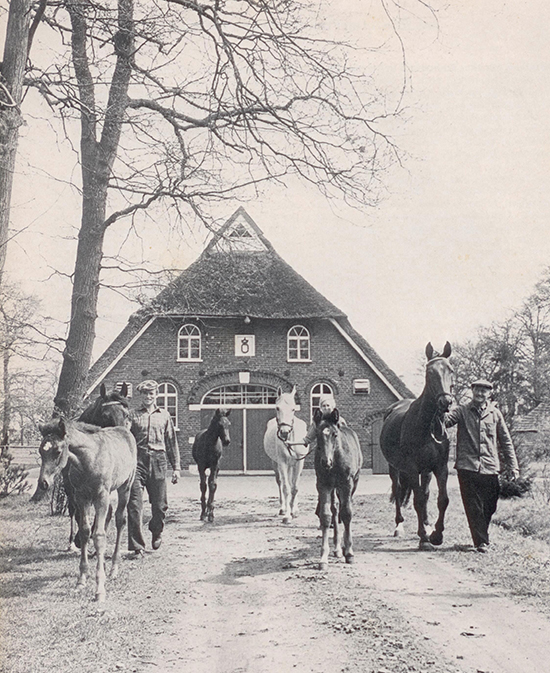
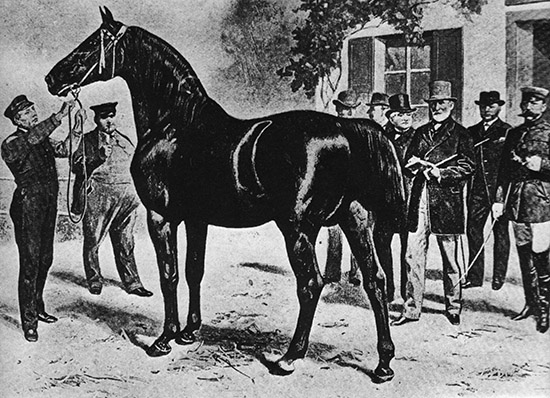
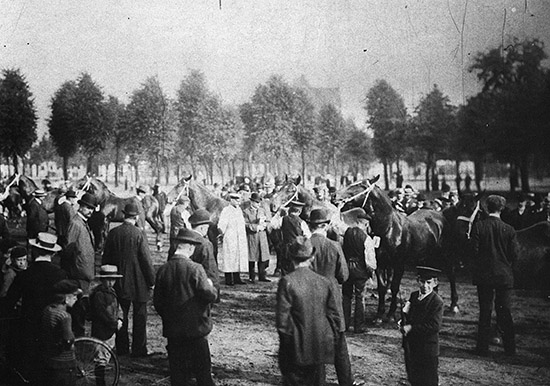
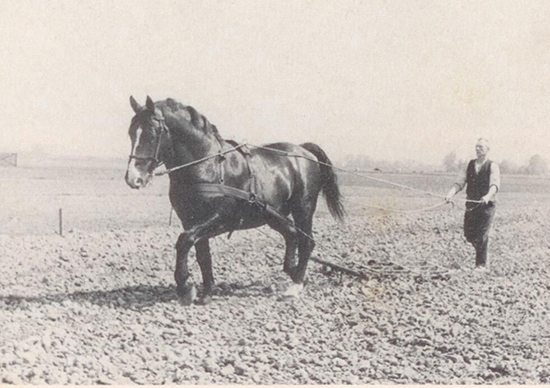
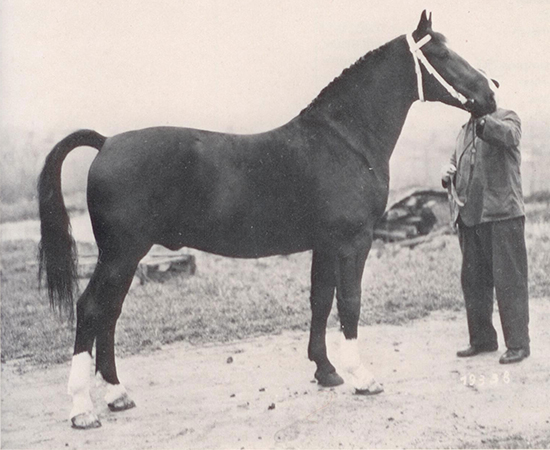
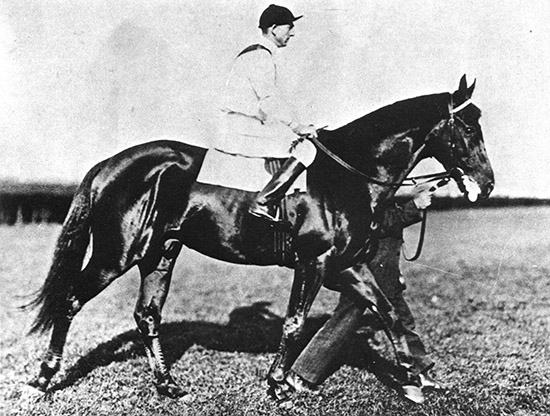
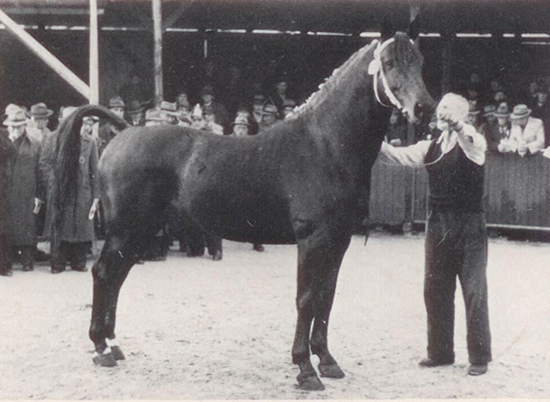
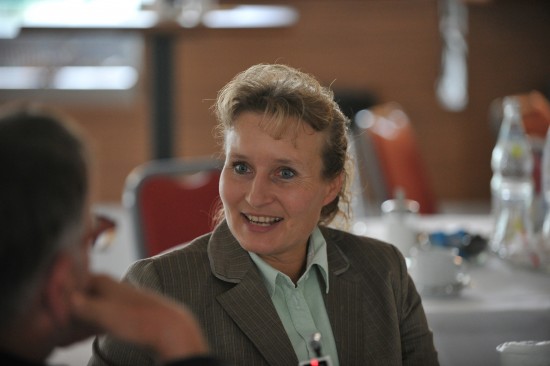

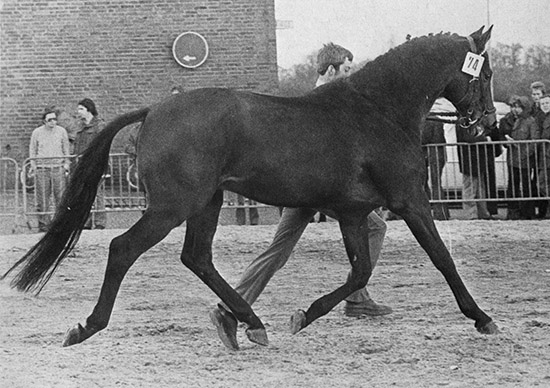
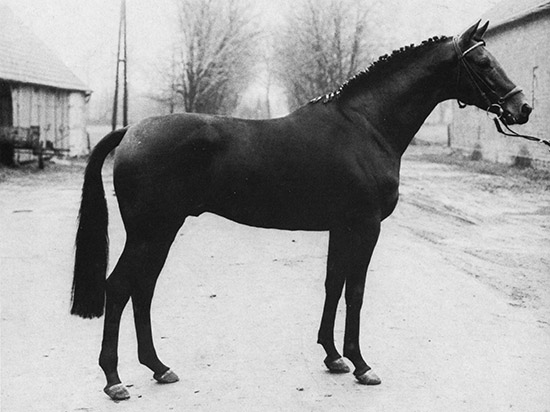
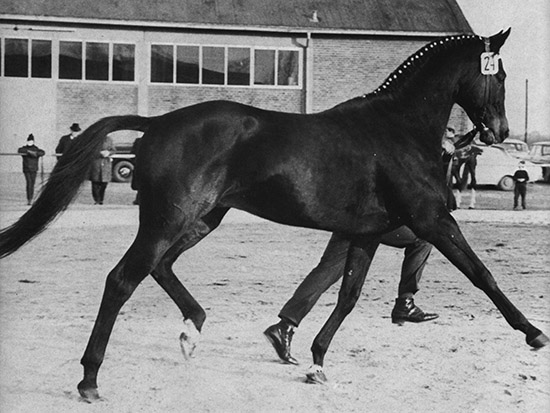
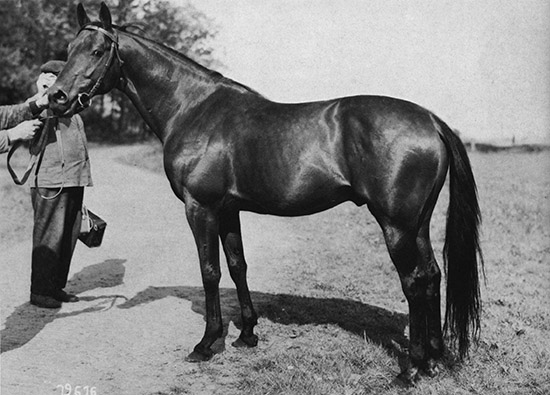
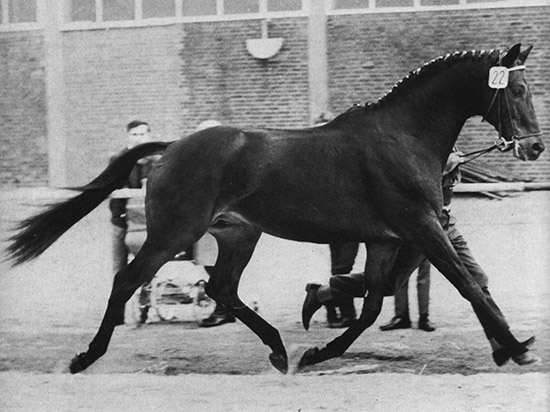
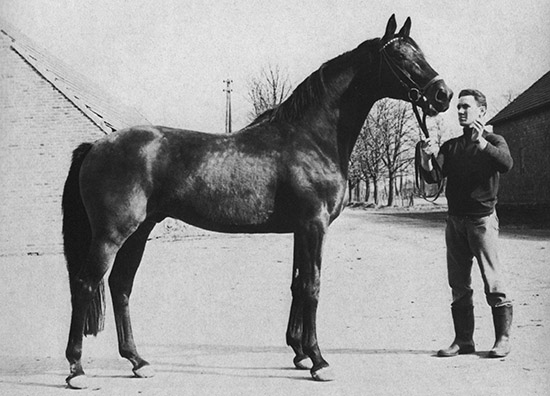
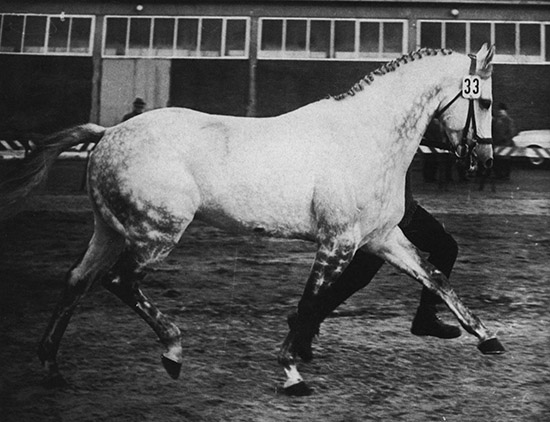
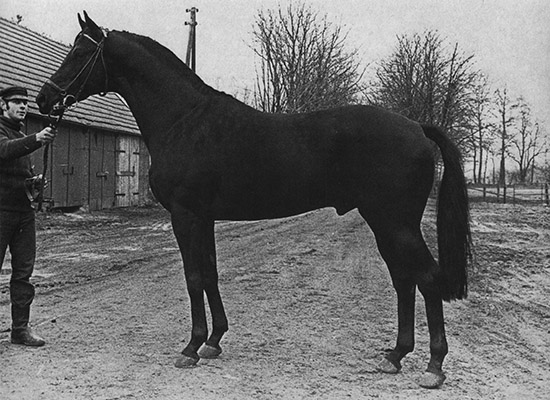
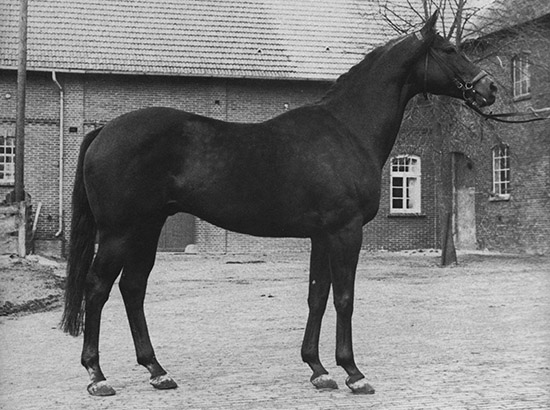
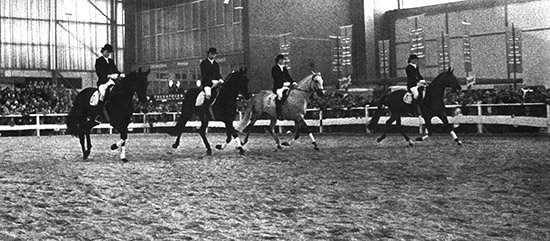
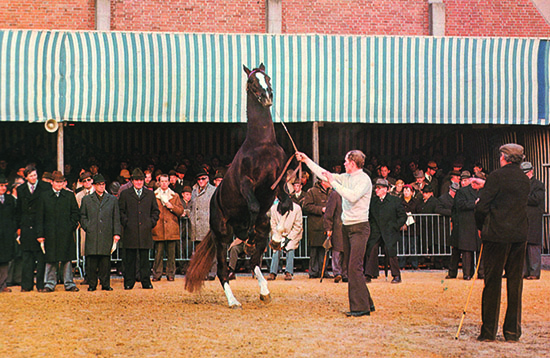
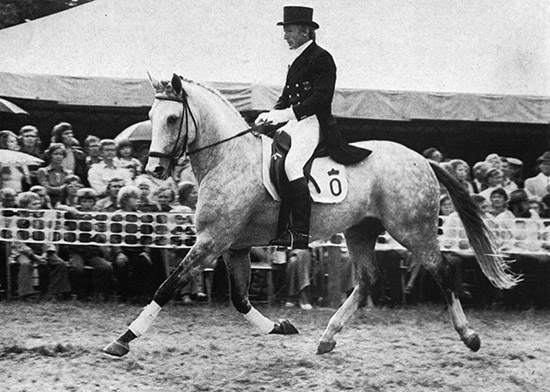
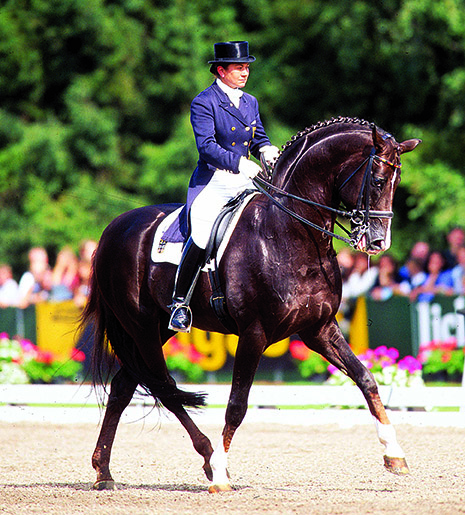
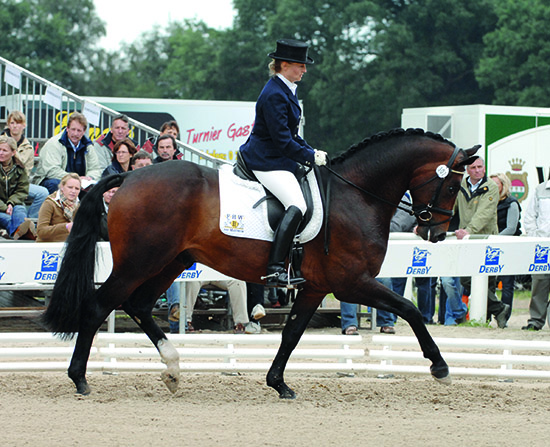
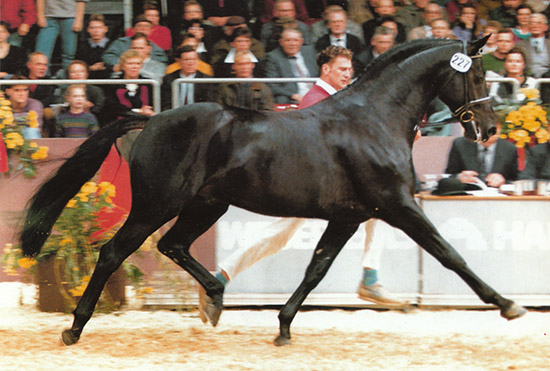
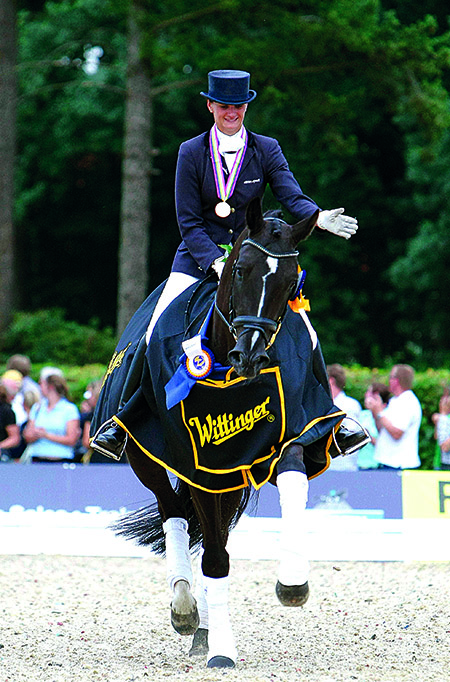
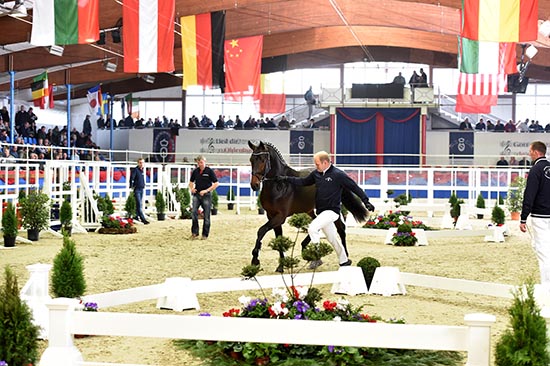
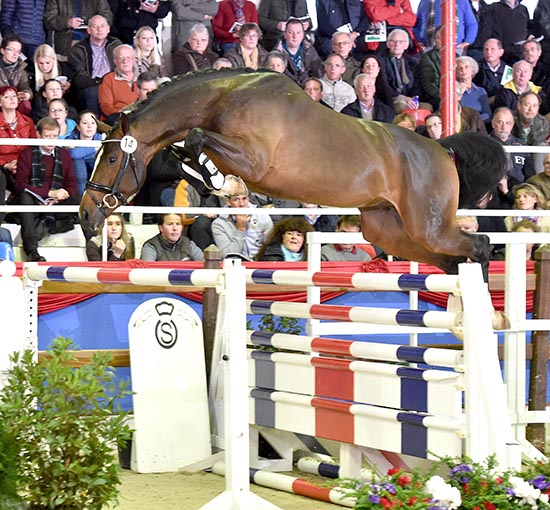
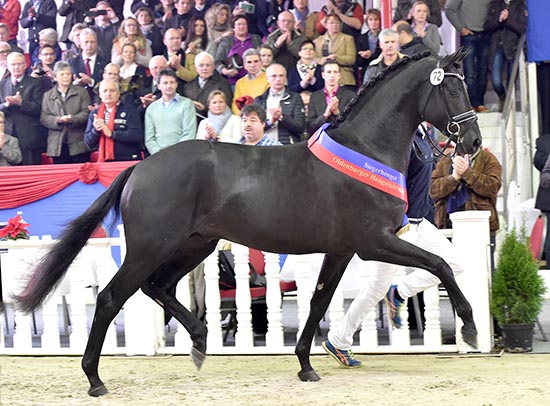

This was a fascinating interview with Katrine and in depth look at the Oldenburger, thank-you. The chapter on the use and present difficulties in finding good thoroughbreds was particularly interesting, along with all the fantastic photo’s.
Only today I was waxing lyrical about the thoroughbreds from “the old days”. Growing up riding these and many quite spectacular examples I could never understand who could ever want a warm-blood in the early 80’s. The sensitivity, feeling and feed back from the horses was completely different.
The breed has certainly changed, they’re getting faster but only at short distances and this where breeding is turning with the resultant change in make of the breed. Thoroughbreds are still extremely important for breeding sport horses. I cant help but day dream what super fantastic horses could be produced with thoroughbreds if thoroughbred breeders stopped breeding for the race-track and turned their attention to breeding them for sport instead, for dressage. Jumpers are more easily found these days as the modern type thoroughbred can more easily be adapted for this discipline, blood is also essential for this discipline.
Overall I agree with Katrine, within the American type it’s very difficult to find quality for sport horses of any kind. Interesting that Katrine mentioned Australia in this regard, though. I have done quite a bit of touring of studs farms in Australia and have been consistently impressed, excited and more than once quite astounded at what an excellent thoroughbred mare base they have, particularly client mares at such farms. Very very good types. These mares to me would make a ready made base for a very interesting warmblood breeding. Further I hope they are used for such as this could make for even more interesting blood for European warmblood breeding. A decline in the racing industry and ever more interest in warmblood breeding there, plus a lack of warmblood mares in Australia could mean there is a big chance that Australia could be the ticket.
Thanks for some lovely memories and interesting insight. Anton